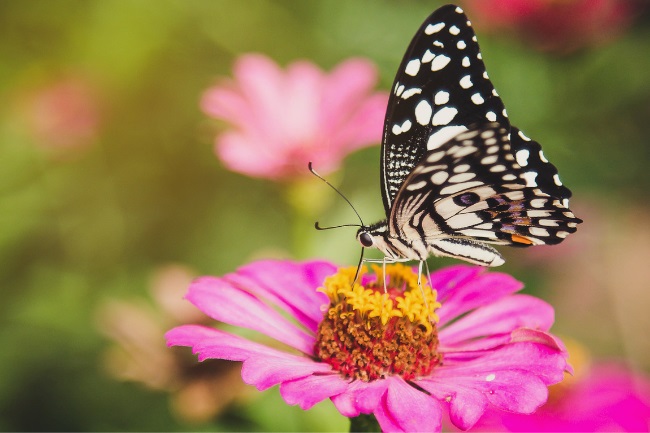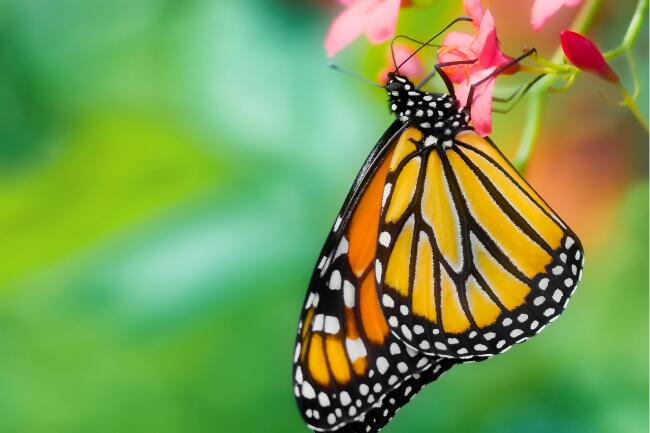All butterflies have eyes. They have two compound eyes made up of hundreds of individual lenses and two simple eyes that can see light.
Contents
Do butterflies have eyes?

As with many species of insect, this question isn’t as easy to answer as you’d suppose.
To start with, yes butterflies do have eyes, but here’s where it gets complicated. Looking at the head of a butterfly it may seem easy to point out their large bulbous eyes and state they have two, however, there’s more to a butterflies sight than meets the eye.
| Eye Structure | Description |
|---|---|
| Compound Eyes | Butterflies have large compound eyes, made up of thousands of tiny lenses called ommatidia |
| Ommatidia | Each ommatidium detects a small part of the visual field, contributing to a mosaic-like image |
| Eye Sensitivity | Butterflies are sensitive to UV and polarized light, helping them navigate and find nectar sources |
| Color Perception | Butterflies can perceive a wide range of colors, including UV and some colors in the red spectrum |
How many eyes does a butterfly have?
The two obvious eyes on the side of the butterflies head are what is known as compound eyes. Many insects have compound eyes, which are made up of many thousands of individual lenses, known as ommatidia, rather than one large lens.
It’s not known whether these many thousands of images are combined within the butterflies mind to create one image or if they process them separately. Either way, it’s a very impressive feat.
Alongside these compound eyes, many butterflies also have simple eyes. Simple eyes are what the butterflies have during their caterpillar stage, and are very small pinpricks compared to the large compound eyes of the adults.
This is probably why few people notice this second pair of eyes the butterfly possesses. The simple eyes are very different from the compound eyes, only able to detect certain stimuli, such as light. They can’t focus with these eyes, leaving the technical work to the larger more precise compound lenses.
Also read: What Caterpillars Turn Into Butterflies? (Species Explained)
What do butterflies see?

To many of us, observing butterflies flitting around the garden, it may seem like they don’t have much need for excellent eyesight. After all, they aren’t programming a computer chip or sewing an elaborate tapestry. Their sole requirement is to find and feed on brightly coloured flowers, so very simply eyesight would be sufficient, right?
| Butterfly Species | Visible Spectrum Range |
|---|---|
| Monarch Butterfly | Ultraviolet (UV) to red wavelengths |
| Painted Lady Butterfly | Ultraviolet (UV) to red wavelengths |
| Swallowtail Butterfly | Ultraviolet (UV) to red wavelengths |
| Red Admiral Butterfly | Ultraviolet (UV) to red wavelengths |
| Blue Morpho Butterfly | Ultraviolet (UV) to blue and green wavelengths |
In fact, in many ways, butterflies eyes could be said to be better than ours.
Colour
Firstly, butterflies can see a much wider array of colours than us, including ultraviolet. Ultraviolet is a wavelength we aren’t able to see with the naked eye, however, if you use specialist camera equipment to take ultraviolet pictures of a flower you’ll be able to see the hidden markings that are specially laid on by the blooms to attract in pollinating insects.
These markings may take the form of a ‘bull’s eye’ over the flower, or of landing lines leading up to where the pollen is found. All in all, flowers are surprisingly blatant when it comes to what they want from their visiting insects.
Even more interestingly scientists have found the range of colours a butterfly can see varies depending on what colours they require to accurately identify the foodplant of their caterpillars. If a butterfly has very fussy caterpillars they have a wider spectrum available to them so they can be sure they are laying their eggs in the right place.
Speed
It’s amazing how much faster the world can be for a tiny insect. A butterflies compound eyes can see 250 frames per second whereas our eyes are only able to see around 45-53.
This superpower may at first seem slightly pointless, however, given the speed at which a butterfly can fly and the speed of a bird you’ll understand why these little creatures require every possible advantage to avoid falling foul of their flapping pursuers.
Scope
It may seem obvious when you think about it but the large compound eyes of an insect have an amazing field of visible compared to our eyes.
While we can only see what is largely straight in front of us butterflies can see partly above, below and behind as well. It’s not 360 vision but it is thought to be around 314 degrees in some species.
Again this is an ideal adaptation to avoid those hungry mouths.
Also read: What do Butterflies Eat and Drink? (Detailed Guide)
Do butterflies have eyes on their wings?

Beyond the eyes butterflies possess on their heads some species that have additional sets of their wings. These eyes aren’t used for looking at anything, instead, they are representations of eyes, marked onto the wings by coloured scales. Usually, they are large circular patterns, coloured with startling blues, whites and blacks.
One of the most familiar species to have these eye marks is the peacock butterfly. The way the butterfly uses these markings can be twofold. Firstly the markings can be used to make a predator think that a larger more ferocious beast is facing them, ready and willing to attack. Butterflies may flap their wings suddenly to startle a predator with this confusion and then to get away.
Another use for eyespots can be to make the attacker think the insect’s head is elsewhere on its body. This can cause a strike to aim at the wrong spot, causing more minor damage and allowing the butterfly to escape.
Also read: What are Butterfly Wings Made of? (The Anatomy Explained)
The importance of sight
We may not think of butterflies as having all that much stress in their lives, yet like all living creatures, they have the never-ending the race to eat and procreate, with the added need to avoid becoming some else’s lunch.
For all this, good sight is essential, so that they are able to find nectar efficiently, locate the correct foodplant for their young and escape the constant threat of being eaten. Therefore, these tiny creatures are forever keeping a sharp eye out, seeing the world in more colour and detail than even we are able to.

